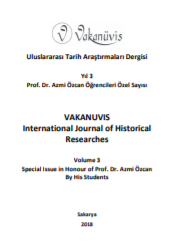Ortaçağda Misk
Musk At Medieval Period
Author(s): Mehmet KavakSubject(s): Economic history, Middle Ages, International relations/trade, Cultural Anthropology / Ethnology
Published by: Serkan YAZICI
Keywords: Musk; Musk-deer; Musk kinds; Musk adulterations; Musk trade;
Summary/Abstract: The medieval travelers, who had journeyed to know the various places and thus continued the tradition of transferring the knowledge about the countries where they had visited, left behind them interesting and detailed stories about musk and musk-deer in the Tibetan, Chinese and Indian regions. Like travelers, many physician, historian and poets wrote about musk in their works. These had provided very precious information about musk deer (also refers about to musk cat, goat and mouse), production, types and trade of it. The musk which clearly being similarly with testicles musk-sac that male musk-deer carried lower part of the womb next to the genital organ of animal is used in the Sanskrit as muṣka (मुष्क) which means the testicles and similarly used in Arabic, Persian, Hebrew, Latin, Syriac, Turkish and other western languages. It is used kastūrī (कस्तूरी) and kastūrikā (कस्तूररका) in Sanskrit and Hindi corresponding to musk and musk-deer. The musk which had important place in Tibb-e Nabawi thanks to it pleasant and intensive smell, used in both medical and perfumery. Moreover, it gained a place as a world-wide commercial commodity and a gift in medieval, after having been collected and preserved well. The musk-sacs that were collected in China were not in demand because they included additive and spoiled during their transportation. On the other hands the most quality Tibetian and Indian musks were mostly preferable, due to both musk-deers fed by various and aromatic herbs and their fast transportation, without being spoiled.
Journal: Vakanüvis- Uluslararası Tarih Araştırmaları Dergisi
- Issue Year: 3/2018
- Issue No: Spec.issue
- Page Range: 188-229
- Page Count: 42
- Language: Turkish

